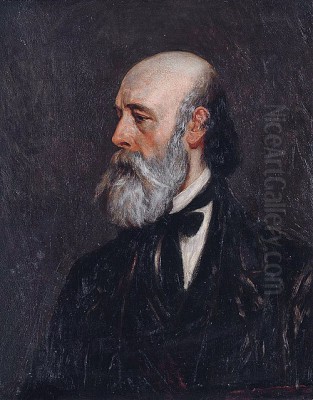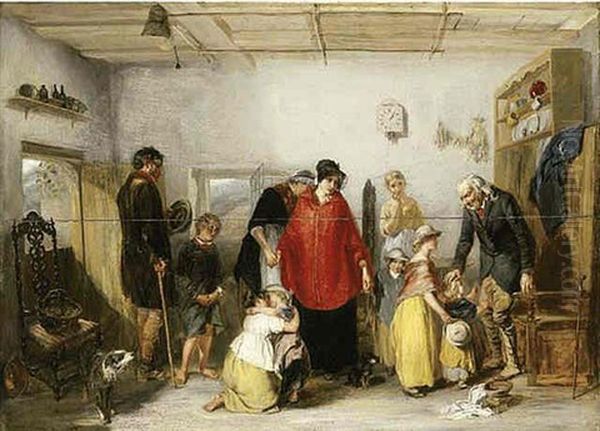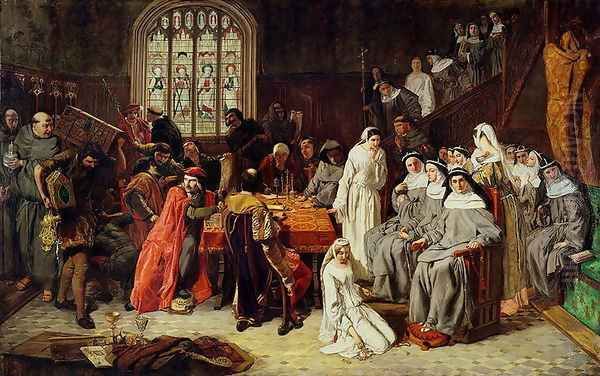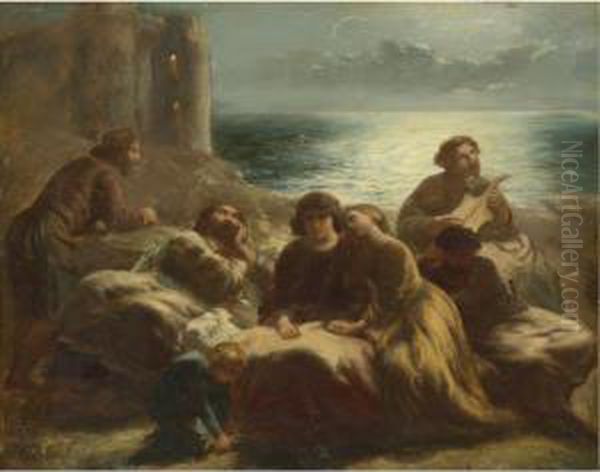
Paul Falconer Poole stands as a significant figure in the landscape of nineteenth-century British art. Born in Bristol, England, likely in 1807, though some sources suggest 1806, he forged a remarkable career despite lacking formal artistic training. Poole rose to prominence through sheer talent, developing a distinctive style characterized by a profound sensitivity to colour, a deep poetic sympathy, and a compelling dramatic force. His journey from a self-taught provincial artist to a respected member of the Royal Academy is a testament to his innate abilities and dedication. He passed away in Hampstead, London, in 1879, leaving behind a body of work that continues to intrigue scholars and art lovers alike.
Early Life and Artistic Awakening
Poole's origins in Bristol placed him outside the central hub of London's art establishment. In the early nineteenth century, opportunities for rigorous artistic education, particularly life drawing, were scarce in the West of England. This lack of formal instruction meant Poole had to rely on his own observations, intuition, and relentless practice to master the fundamentals of painting. This self-directed learning process likely contributed to the unique and somewhat unconventional qualities found in his later work, setting him apart from academy-trained contemporaries.
His ambition, however, was clear from early on. He sought recognition within the established art world, and his first major step was exhibiting at the prestigious Royal Academy in London. Sources vary slightly on the exact year, but it was likely around 1830 when he presented The Well: A Scene at Naples. This early work, depicting a picturesque Italian scene, signalled his arrival and demonstrated his burgeoning talent, particularly his handling of light and atmosphere, even at this nascent stage of his career. It marked the beginning of a long association with the Academy, which would become the primary venue for showcasing his evolving art.
The Development of a Romantic Vision

Poole's art is firmly rooted in the Romantic tradition that flourished in Britain during the early to mid-nineteenth century. His paintings often evoke strong emotions, explore themes of nature, history, and literature, and display a fascination with the dramatic and the sublime. He possessed an exceptional innate gift for colour, often drawing comparisons to the Venetian masters for the richness and depth of his palette. This, combined with his poetic sensibility, allowed him to imbue his canvases with a palpable mood and atmosphere.
His work can broadly be seen as falling into two main categories: the pastoral and the dramatic. Early paintings like The Farewell and The Emigrant's Departure (exhibited RA 1838) exemplify his ability to capture pathos and human emotion within carefully composed settings. These works touched upon contemporary social themes, such as emigration, lending a layer of relevance to their romantic appeal. They showcased his growing confidence in figure composition and narrative storytelling, key elements that would define his mature style.
Achieving Recognition: The Royal Academy and Major Works
Poole's talent did not go unnoticed for long. A significant breakthrough came in 1843 when his painting Solomon Eagle Exhorting the People to Repentance during the Plague of London won a substantial prize of £300 in the competitions held for the decoration of the new Houses of Parliament at Westminster Hall. This historical subject, depicting a dramatic moment from Daniel Defoe's A Journal of the Plague Year, perfectly suited Poole's flair for theatricality and powerful emotional expression. The award brought him considerable public attention and critical acclaim.
This success paved the way for his election as an Associate of the Royal Academy (ARA) in 1846. This was a crucial step in establishing his professional standing. He continued to exhibit regularly at the RA, presenting works that solidified his reputation. Notable paintings from this period include The Visitation and Surrender of Syon Nunnery (1846), Edward III's Generosity to the People of Calais (1847), and the powerful historical piece The Goths in Italy (1851). His full election as a Royal Academician (RA) followed in 1861 (some sources state 1860), cementing his place among the leading artists of his generation.
Exploring Pastoral Themes
Alongside his dramatic historical and literary subjects, Poole excelled in creating idyllic pastoral scenes. These works often celebrate the beauty of the English countryside and evoke a sense of timeless tranquility, though sometimes tinged with melancholy. One of his most famous works in this vein is The May Queen or May Day (exhibited RA 1852), a charming depiction of rural festivities. This painting captures the innocence and joy associated with traditional country life, rendered with his characteristic sensitivity to light and colour.

Other works, like The Mountaineer (1853) and The Song of the Troubadour (1854), continue this exploration of romanticized rural or historical settings. Paintings such as Watercress Gatherers (1870) show his continued interest in depicting figures within landscape settings, focusing on the quiet dignity of rural labour. These pastoral works offered a counterpoint to his more intense dramatic paintings, showcasing the breadth of his thematic concerns and his ability to adapt his style to different moods and subjects. They connect him to a long tradition of British landscape and genre painting, echoing earlier masters like Thomas Gainsborough in their poetic feeling for nature.
Dramatic Narratives: History, Literature, and Religion
Poole's dramatic imagination found fertile ground in historical episodes, literary scenes, and biblical narratives. His Solomon Eagle remained a benchmark, but he returned frequently to subjects that allowed for heightened emotion and theatrical composition. He drew inspiration from Shakespeare, notably with Ferdinand and Miranda (from The Tempest, exhibited RA 1849) and The Last Scene in Lear (exhibited RA 1858). These works demonstrate his ability to translate the power of Shakespearean drama into visual terms.
History provided another rich source. Following The Goths in Italy, he painted The Escape of Glaucus and Ione with the blind girl Nydia from Pompeii (exhibited RA 1860), inspired by Edward Bulwer-Lytton's popular novel The Last Days of Pompeii. This subject, depicting flight from volcanic destruction, allowed for dynamic composition and intense emotion. His approach to history painting differed from the meticulous detail favoured by contemporaries like Daniel Maclise, focusing instead on mood, atmosphere, and the psychological state of the figures.
Biblical themes also appeared in his oeuvre, often treated with the same dramatic intensity. Works like By the Rivers of Babylon and The Prodigal Son (1869) allowed him to explore universal human experiences of exile, loss, and redemption. His late work Ezekiel's Vision (exhibited RA 1875) tackled a complex prophetic subject, showcasing his enduring ambition and imaginative power. These dramatic works often recall the scale and intensity found in the paintings of John Martin, another artist known for his spectacular historical and biblical scenes.
Colour, Technique, and Artistic Style
Central to Poole's artistic identity was his mastery of colour. Critics consistently praised his rich, harmonious, and often bold palette. His handling of colour was frequently compared to the Venetian school, particularly Titian, for its depth and luminosity. He used colour not just descriptively but expressively, to build atmosphere, convey emotion, and unify his compositions. His technique often involved visible brushwork and a less polished finish than was common among many Victorian painters, contributing to the vibrancy and immediacy of his surfaces.

His approach contrasted significantly with the detailed precision and bright, clear colours favoured by the Pre-Raphaelite Brotherhood, whose members like John Everett Millais, William Holman Hunt, and Dante Gabriel Rossetti were rising to prominence during Poole's mid-career. While the Pre-Raphaelites sought truth to nature through meticulous rendering, Poole pursued emotional and poetic truth through suggestion, atmosphere, and the evocative power of colour and light. His style remained distinctly Romantic, prioritizing feeling and imagination over objective realism, aligning him more closely with the sensibilities of earlier figures like J.M.W. Turner or contemporaries like William Etty, another noted colourist.
Connections and Contemporaries in the Art World
Although largely self-taught, Poole was not isolated from the art world. His long association with the Royal Academy placed him in regular contact with fellow artists. He exhibited alongside prominent Academicians such as the landscape painters Thomas Creswick and Clarkson Stanfield, and the historical painter Charles Landseer. His work was seen and discussed within this influential circle.
His personal life also intersected dramatically with the art world through his relationship with Philippa Danby, the wife of fellow Bristol artist Francis Danby. Poole eloped with Philippa around 1829, a scandal that significantly impacted Francis Danby's career, forcing him to leave London and live abroad for several years. Poole himself faced financial difficulties and reputedly spent a period living near Lake Geneva in Switzerland, possibly with Philippa, before eventually returning to England. He later married Philippa after Francis Danby's death. This episode highlights the sometimes turbulent personal relationships within the relatively small London art community.
A more positive connection involved the Swedish artist Carl Larsson. During a visit to England in 1843, Larsson reportedly shared accommodation with Poole for a time and acknowledged learning from the English painter's romantic approach to nature and his use of colour. This interaction, though perhaps brief, indicates Poole's willingness to engage with younger artists. Furthermore, his work was sometimes discussed in relation to George Frederic Watts, another major Victorian figure, particularly in the context of imaginative or "fantasy" painting, where Poole was considered second only to Watts by some critics. His unique style positioned him distinctly amidst the varied trends of Victorian art, from the lingering influence of Romanticism to the rise of Pre-Raphaelitism and later Aestheticism, represented by figures like Edward Burne-Jones and Frederic Leighton.
Personal Challenges and Later Life

Poole's career was marked by significant artistic success, but his personal life included periods of considerable difficulty. The elopement with Philippa Danby undoubtedly caused social and potentially financial strain in the early years. Reports of financial struggles persisted, possibly contributing to his time spent living abroad in Switzerland during the 1830s or early 1840s. This period away from the London scene might have temporarily slowed his professional advancement, although he continued to develop his art.
Upon his return to England, he re-established himself, leading to his election as ARA in 1846. He eventually settled in Hampstead, a North London suburb popular with artists and writers. He lived at a house called 'Uplands' for the last twenty-five years or so of his life. It was here that he continued to paint and exhibit, producing some of his most ambitious late works. Despite earlier hardships, his later years seem to have been relatively stable, allowing him to consolidate his position as a senior figure in the British art world until his death in September 1879.
Later Works and Enduring Legacy
In his later years, Poole continued to produce significant works, often tackling ambitious subjects. The Lion in the Path (1873) and the aforementioned Ezekiel's Vision (1875) demonstrate his undiminished imaginative power. He also returned to literary themes with The Meeting of Oberon and Titania (1876) and Imogen before the Cave of Belarius (from Shakespeare's Cymbeline, 1878). These late paintings maintain his characteristic emphasis on colour, mood, and dramatic effect, even if some critics noted a loosening of technique compared to his earlier work.
Paul Falconer Poole's legacy rests on his unique position as a largely self-taught artist who achieved significant recognition through his distinctive Romantic style. He was celebrated in his time as a master colourist and a painter of deep poetic feeling and dramatic intensity. While his fame may have been somewhat eclipsed in the twentieth century by the enduring popularity of the Pre-Raphaelites or the monumental status of Turner, his contribution remains significant. His works are held in major public collections, including Tate Britain and the Victoria and Albert Museum (formerly the South Kensington Museum), ensuring his art continues to be accessible.
He represents a vital strand of British Romanticism that persisted through the mid-Victorian era, prioritizing imagination, emotion, and the expressive potential of paint itself. His journey from provincial obscurity to the heart of the London art establishment, achieved on his own terms and through the power of his unique vision, serves as an inspiring example of artistic determination and singular talent. His paintings continue to resonate with viewers drawn to their rich colour, atmospheric depth, and evocative storytelling.